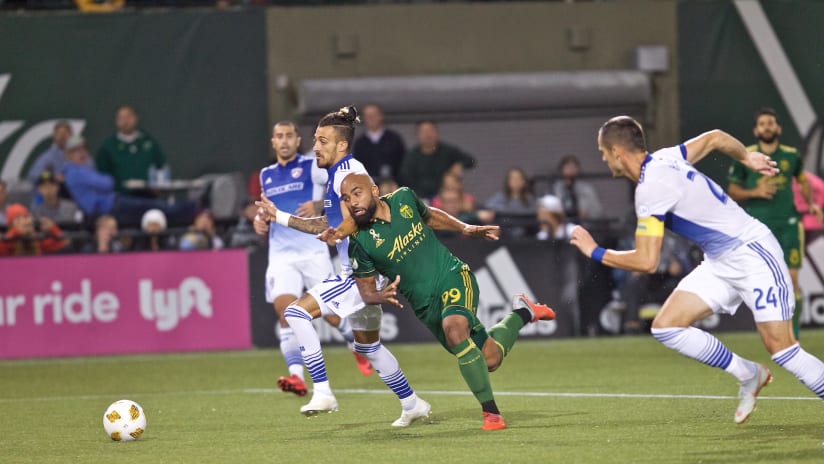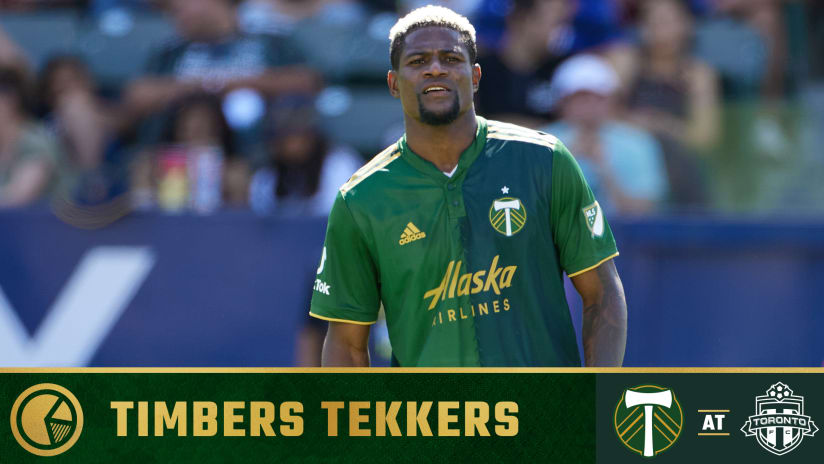PORTLAND, Ore. – The Portland Timbers have chosen formations that used two forwards on only six occasions during MLS’ 2018 season, but before Saturday’s match against FC Dallas, each forward pairing had featured one of Diego Valeri or Dairon Asprilla, players most don’t consider natural, through-the-middle forwards. Valeri is an attacking midfielder; Asprilla, a winger.
Against, Dallas, though, the team’s first-choice striker, Samuel Armenteros, was paired with the next player on the depth chart, Jeremy Ebobisse, for the first time this season. Including U.S. Open Cup play, it was only the second time this season the Timbers have done with two strikers up top.
“I think it was a good partnership on some of the things we tried to do,” Giovanni Savarese said on Tuesday, when asked to reflect on the duo’s performance in Portland’s 0-0 draw. “They helped us in some of the things we tried to accomplish, the style of play against Dallas that we had.
“But, of course, they’re two players who haven’t played a lot, together, so there are a few things that they could do better and that we could make them be sharper playing with each other.”
The good and the bad – or, the familiar and unfamiliar – was on display throughout Saturday’s game. With Ebobisse’s more physical presence beside him, Armenteros was free to move into space around his partner, with the defenders occupied by the younger forward also diverting attention from the team’s attacking midfielder, Valeri.

Although Ebobisse played well on Saturday, moments like this are less about anything extraordinary from the player than the mere virtues of playing a second forward. From the match’s opening moments, when a Jorge Villafaña cross found Ebobisse near the Dallas penalty spot, the Timbers established Ebobisse as a potential focal point of direct play, meaning even when he wasn’t close to the ball, players like Dallas center back Matt Hedges had to account for him.
Even when the Timbers weren’t playing directly, having two forwards meant, when one drops into space (like we see below), the team can maintain a threat along the defense and give opponents a disincentive to following players into midfield. Nothing comes from this example, below, but off camera to the right, Armenteros is able to stay alongside the defense, and when a Dallas defender (Reto Zeigler) does elect to follow Ebobisse, he leaves space for Valeri to run into.
“What we were looking for from the two of them in regards to the type of play that we tried, both did their job in giving us that,” Savarese explained. “It’s good to have different options.
“We have seen so many different things, this year – different partnerships; different players – so for us, it’s important that the two of them, due to the fact that (Sebastián) Blanco was out, were the ones to play, especially for the different qualities that each has to complement each other.”
Ebobisse and Armenteros are very different types of players, yet both have the ability to play both along the defense, in wide spaces, as well as dropping back into midfield. Whereas Armenteros’ quick movements in subtle skills on the ball help distinguish his quality, Ebobisse pairs a pure striker's movements with a field awareness that projects him to be a positive in all phases of the game. Together, the duo has enough complementary skills and needed differences to feed off each other, given enough time to do so.
Yet Savarese’s words about Blanco, above, may be crucial to understanding why the partnership hasn’t been seen before. Even though the Argentine attacker has spent some time in central midfield, this season, Blanco’s role alongside Valeri as one of the team’s tandem No. 10s has been on the most positive part of the Timbers’ attack. But once you pencil in two No. 10s into a formation, it’s difficult with the Timbers’ personnel to come up with a viable formation that also features two forwards.
Add in the fact that it’s been nine halves since the team got a goal from a striker and Savarese has reason to think of his 10s first.
“I think that we need a few more goals,” Savarese conceded. “But that doesn’t mean that the guys are not working. They are doing their job. The guys are working very hard. And the important part is that I, personally, and the staff believe in the players that we have.”
Just as with his note on Blanco’s Saturday absence, this may be an elucidating thought. For Savarese, the team could be scoring more goals. He said as much when talking about the players’ execution on Saturday, when they were able to threaten (but not breach) Dallas’ goal. Yet the players being selected are also working hard, doing their jobs. This isn’t necessarily a matter of individual performances being out of character. It’s a matter of parts meshing in a way that can make the team more productive.
That reality defines the tension of whether (and how often) we will see the two-forward setup in the future. It isn’t necessarily about Armenteros or Ebobisse in isolation, but about the relationship between the two. It’s about how that dynamic might evolve, how it fits against the coming opponents, and whether it will help address the team’s goalscoring needs, be it with the forwards scoring goals or others.
“That’s the most important part,” Savarese said, about his belief in his players, eventually tying that feeling into the team’s broader goals. “If we continue to work and, God willing, make it into the playoffs, I think that we are going to be a tough team to play against. But we cannot think beyond this weekend, which is going to be a very tough game.”
A tough game where we may see the Armenteros-Ebobisse partnership return. Or, with Blanco available, the team may revert to its one-forward sets. But with Portland continuing to look for more goals, getting another forward onto the field will remain a discussed option, even if, in Blanco and Valeri, there will always be factors to consider first.












